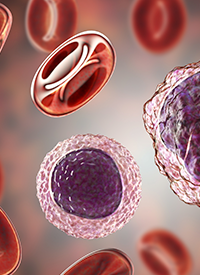News
Article
VDA-1102 Demonstrates Favorable Activity in Mycosis Fungoides
Author(s):
VDA-1102 led to an objective response rate of 56% in patients with mycosis fungoides, according to findings from an interim analysis of a phase 2a study.
VDA-1102 in Mycosis Fungoides
Image Credit: © Dr_Microbe
- stock.adobe.com

Treatment with the non-toxic small molecule VDA-1102 led to an objective response rate of 56%, a complete response rate of 22%, and a partial response rate of 34% in patients with mycosis fungoides, a form of cutaneous T-cell lymphoma (CTCL), according to findings from an interim analysis of an ongoing phase 2a study.1
Additional findings from the interim analysis, which was conducted in half the trial population (n = 9/16), showed that responses occurred between 8 and 12 weeks, comparing favorably with mechlorethamine, the current standard of care. Mechlorethamine is an alkylating agent approved as topical therapy for the treatment of patients with stage 1A and 1B mycosis fungoides–type CTCL following prior skin-directed therapy. However, the gel is associated with a CR rate of only 13% and a median time to response of 26 weeks.1,2 Furthermore, mechlorethamine is associated with adverse effects (AEs) such as dermatitis, pruritus, skin ulceration or blistering, bacterial skin infection, and hyperpigmentation.2
Regarding safety, all AEs observed with VDA-1102 were local and mild, with the exception of 1 moderate event. All patients recovered, and none experienced disease progression during the 4 months on trial.1
“These interim results are another important confirmation that Vidac Pharma’s approach of attacking cancer at its core has substantial therapeutic potential. Our drug candidates reverse the abnormal metabolism that is a characteristic of all cancer cells, halting tumor proliferation and immune resistance. What we are seeing bears the promise of applying these drugs across a wide range of cancers,” Max Herzberg, chief executive officer of Vidac Pharma, said in a news release.
VDA-1102 ointment is a first-in-class, anti-neoplastic treatment that selectively targets malignant cutaneous cells with minimal effects on surrounding healthy tissue. By selectively modulating VDAC/HK2, a molecular system specific to glycolysis and mitochondrial function in cancer cells, VDA-1102 can induce malignant cell death, sparing normal cells.3
Previously, VDA-1102 demonstrated significant in vitro and in vivo efficacy in actinic keratosis and cutaneous squamous cell carcinoma models. The lesion reduction seen with VDA-1102 treatment was similar to the lesion reduction rates reported with agents approved for patients with actinic keratosis, such as ingenol mebutate (Picato) and 5-fluorouracil. Additionally, VDA-1102 proved safe and effective in findings from a phase 2b study (NCT03538951) in patients with actinic keratosis, serving as the basis for the drug’s continued development in CTCL.2 In the phase 2b trial, VDA-1102 demonstrated a 40% complete clearance rate and an 80% lesion reduction rate, with slight erythema observed after 7 to 8 weeks of treatment. The safety data generated during the clinical development of VDA-1102 in actinic keratosis were considered sufficient by the Helsinki Committee and Ministry of Health, allowing for the initiation of the phase 2 trial with the agent in patients with CTCL.
The open-label, placebo-controlled trial is evaluating the safety and efficacy of VDA-1102 as a topical ointment treatment for 12 weeks in adult patients with relapsed stage 1 mycosis fungoides.1
The trial was initiated in December 2020 at Rabin Center (Beilinson Hospital) in Israel under the supervision of professor Emmilia Hodak, MD.
Interim results capturing the full population are expected in the second quarter of 2024, with final results planned to read out in the fourth quarter.
References
- Vidac Pharma reports positive interim phase 2a data in orphan disease cutaneous T-cell lymphoma (CTCL) with lead asset VDA-1102. News release. Vidac Pharma. January 29, 2024. Accessed January 29, 2024. https://ml-eu.globenewswire.com/Resource/Download/b24ba0f7-0f5d-496e-b919-9cb9e3ee3155
- Valchlor Prescribing information. FDA. August 2013. Accessed January 29, 2024. https://www.accessdata.fda.gov/drugsatfda_docs/label/2013/202317lbl.pdf
- Vidac Pharma. VDA-1102 ointment. Accessed January 29, 2024. https://vidacpharma.com/en/pipeline/vda-1102-ointment






%20(2)%201-Recovered-Recovered-Recovered-Recovered-Recovered.jpg?fit=crop&auto=format)

%20(2)%201-Recovered-Recovered-Recovered-Recovered-Recovered.jpg?fit=crop&auto=format)
%20(2)%201-Recovered-Recovered-Recovered-Recovered-Recovered.jpg?fit=crop&auto=format)